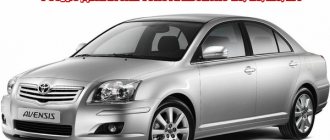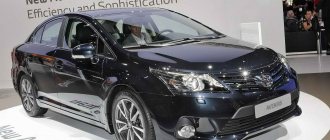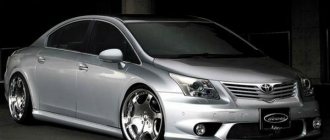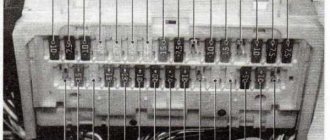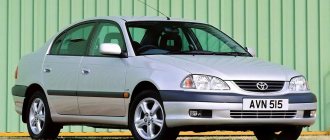Car history
This car was specially created for the European market. It replaced the already outdated Toyota Carina E. In total, the Japanese company released 3 generations. The first family was introduced in 1997. The second generation Toyota Avensis was released in 2003 and remained on the assembly line until 2008. The Japanese presented the last 3rd generation of Toyota Avensis during the Paris Motor Show in 2008. Already in 2011, the company released an updated version. However, this was not the last restyling.
The next update was presented in 2015 during the spring motor show in Geneva. It was in this version that the car was produced at the plant until March 2021. Then it was decided to completely complete the assembly of the Japanese model. In this article we will take a closer look at the restyled 3rd generation Toyota Avensis. The appearance of these cars is closely intertwined with the new Toyota Corolla model, but the parameters and characteristics are different.
Who buys these cars
They are worthy of their class. Although the predecessors in the person of Karina E still have their admirers. Because they are, according to them, the embodiment of invulnerability.
If you like modern, comfortable family cars, then buy Avensis 1997 - 2003. But remember, they are not cheap and expensive to maintain.
Exterior
If you look at the new Toyota Avensis, you can actually see some similarities with the Corolla. Only the dimensions are slightly different. As for the front optics, it has nothing in common with the previous 2nd generation Toyota Avensis. The optics boast LED and halogen technology. On the top there is a place for LED daytime running lights. Closer to the central part you can see turn signals with LED filling. The head optics received halogen lamps, but more expensive versions will have full LED optics.
It has a small radiator grille with the Toyota emblem on it. As for the pseudo-grille, this is exactly what most car enthusiasts consider it to be; it is equipped with two chrome strips that diverge from the “nameplate”. There are also small gaps necessary for airflow of the power plant. However, in practice, they can be classified more as a decorative format than for cooling the engine.
All Toyota Avensis trim levels will be equipped with a black grille and chrome inserts. They decided to paint the bumper of the 3rd generation Toyota Avensis in body color. Its central part now has a real grille, which is responsible for blowing the power unit. There was room on the sides for additional holes, which are needed more for aerodynamics and not for engine cooling.
In addition, you can see fog lights made of LEDs. As you can see, the model boasts a seriously modified front end. But the hood was hardly touched. It was decided to raise its central part a little. As a result, the hood seems to copy the outlines of the radiator grille. But we decided not to change the side parts, which have sharp ends.
The name "Avensis" comes from the French word "advancer", which means "to advance" and indicates a step forward compared to its predecessor, the Carina E.
The side of the third generation Toyota Avensis no longer looks as radically changed as the front. Some experts believe that the company's design team has left the forms of the previous family. External mirrors were installed on the sides of the door body, as before. As for the usual recess at the bottom of the doors, it is also there. However, there were no changes at all. This may include the presence of a turn signal on the same mirrors. The new generation has a more compact repeater.
In addition to this, the new product received more expressive lining near the handles. Due to the fact that the front and rear lighting have a different shape, the appearance of the side fenders has also changed. If we speak for the Toyota Avensis station wagon, then this body is equipped with minor changes in the rear wings. For example, this includes a strict horizontal line in the area of the rear pillar.
The car rests on 16-inch branded light alloy wheels, but more expensive versions can boast 17- and even 18-inch wheels. The height of the ground clearance was quite modest 140 millimeters. The rear of the new product looks the same for both the 4-door body and the more practical station wagon. The only differences can be seen in the luggage compartment lid. In comparison with the 2nd generation Toyota Avensis, the new car received LED optics. Like earlier, the rear lights are located on the body and trunk lid, although outwardly the optics do not look divided.
The central part of the trunk lid has the traditional Toyota badge. Horizontal chrome lines radiate from it in different directions, which is a novelty. The trunk lid itself, under the optics, is equipped with a semicircular recess, which perfectly emphasizes the modern shape of the body. Its uppermost part is dedicated to the rear camera, license plate illumination, as well as the luggage compartment opening handle for the standard version of the car. There was a small elevation that played the role of a spoiler.
Interior
Speaking for the interior of the Toyota Avensis, they have done a lot of work on it. As a result, it has become higher quality and more modern. The front passengers have excellent leather-upholstered seats. These seats have 8-way power adjustments and are heated. There is good lateral support. In the driver's seat, Japanese engineers decided to install a steering column with leather trim. It is quite thick and comfortable. The 4-spoke multifunction steering wheel, equipped with chrome inserts, lies comfortably in your hands.
In total, 18 keys were placed on the “steering wheel”, which allow you to control “music” and “cruise”. There was no adjustment in height and reach. Behind the wheel, the Japanese installed a dashboard with aggressive analog gauges placed in large wells with chrome trim. In the middle there was a place for a compact 4.2-inch color TFT on-board computer, which provides an abundance of necessary information about the car. The wells themselves have 2 sensors. The tachometer and oil temperature are together in one well, and the speedometer and fuel level sensor are placed in the other well.
The front panel of the 3rd generation Toyota Avensis has an unusual beveled shape in the middle part. In the middle there was a place for narrow deflectors of the ventilation system, which have a chrome line. An emergency warning button was placed between them. The center console has an 8-inch multimedia center display that supports touch controls. Its Japanese engineers went a little deeper inside.
As for the side keys themselves, they were also slightly deeper inward. To make it easier to control the multimedia system, 2 washers were placed. Under the display there is a separate “climate” block, which includes a compact display, a couple of washers with a chrome edging and some keys. There is also a panel with connectors for charging electronic gadgets and a 12V socket.
The designers managed to stylishly design the tunnel of the Toyota Avensis car. On its upper part there are washers that allow you to control the heating of the seats. Next you can notice the compact switch for a “variator” or manual transmission. Next comes the key that turns on the sports mode. After it you can see the only cup holder that received a cover. Between the front seats there was room for a comfortable armrest with a massive glove compartment or mini-fridge. There are no questions about the quality of assembly and finishing materials.
You can also see leather upholstery on the second row. There is a sofa with mounts for a child seat, as well as a folding armrest and two cup holders. There is no point in talking about the abundance of free space. However, it is generally sufficient in both the first and second rows. Although it is designed for three people, it will be more comfortable for only two.
The car is equipped with a good luggage compartment, but it did not receive various boxes that would add practicality. The volume itself is not bad – 509 liters. The seats cannot be removed (this is only available for the Toyota Avensis station wagon), but there is a hatch for skis. It’s interesting that they decided to decorate the doors from the inside, which received wood inserts, leather armrests and a small pocket. The underground niche has only a compact “dock”.
Specifications
Power unit
As for the technical characteristics of the Toyota Avensis, there are a sufficient number of engines and 2 transmission options, so everyone can choose something to their liking. There are engines running on gasoline (3 engines) and diesel fuel (2 engines). The updated Toyota Avensis received slightly modified petrol and a seriously modernized range of diesel power units.
The basic version features a 1.6-liter naturally aspirated 132-horsepower (160 Nm) power plant. The fuel consumption of Toyota Avensis in the combined cycle will be no more than 6.1 liters of gasoline for every 100 kilometers. This allows you to accelerate from zero to the first “hundred” in 10.4 seconds. The speed limit is 200 kilometers per hour.
Next comes a 147-horsepower (180 Nm) 4-cylinder 1.8-liter engine. Its consumption will be approximately 5.9-6 liters of fuel in average mode for every 100 kilometers. It is enough to accelerate to 200 kilometers per hour. Acceleration from zero to 100 km/h takes 9.4-10.4 (depending on the gearbox).
But the most powerful version has a 2.0-liter engine that is capable of generating 152 horsepower (196 Nm). Its “fuel appetite” will be slightly larger than the previous unit - about 6.1 liters of gasoline for every 100 kilometers in mixed mode. It allows you to accelerate from standstill to a speed mark of 100 kilometers per hour in 10 seconds. But the “maximum speed” will be a little better – 205 km/h.
Before the restyling of the 3rd generation Toyota Avensis, the car had supercharged diesel engines: 2.0 D-4D, which developed 126 “horses” (310 Nm) and 2.2 D-4D, which received a power of 150-177 horsepower (340-400 Nm). But after modernizing the cars, they decided to retire them. Instead, Japanese engineers decided to equip the new products with a 1.6-liter turbocharged power plant D-4D, which generates 112 horsepower (270 Nm), as well as a version of the D-4D, which has a displacement and generates 143 “horses” (320 Nm). Fuel consumption of Toyota Avensis diesel varies between 4.1-4.5 liters of diesel fuel for every 100 km.
Transmission
For basic versions and engines, the Japanese have provided a 6-speed manual gearbox. All other versions have a choice: either a 6-speed manual transmission or a CVT. As for diesel options, they only work with a manual gearbox.
Chassis
As a base, Japanese engineers decided to use the MC platform, which involves an independent suspension based on McPherson struts for the front. The rear one received double wishbones with a longitudinal beam at the rear. In addition to this, the car has softer shock absorbers and springs. As for the anti-roll bars, on the contrary, they are more rigid. Driving the car is easy with the help of an electric power steering wheel. The brake system of Toyota Avensis is powerful. The front wheels boast 320 mm (ventilated) and the rear wheels have 290 mm “pancakes”.
Safety
The new restyled Toyota Avensis 3rd generation has received a good level of safety. Even the basic options have a solid set, which can already include 7 airbags. In the front row for two people there is an additional airbag in the area of the driver's knees and 4 airbags around the perimeter of the car to protect passengers as much as possible from a side impact. So, the Japanese model is equipped by default with:
- a system that prevents collisions;
- ABS, EBS;
- braking assistant;
- "cruise"
- Toyota Avensis stabilization system;
- lane monitoring;
- tire pressure control;
- Immobilizer;
- Downhill movement assistant.
In addition, experts installed a variety of light and rain sensors in the new car. Already in the initial version there is a technology that can recognize pedestrians, informing the driver in the dark. This also includes SmartKey keyless access, which helps to warm up, start or turn off the power unit from a distance.
It is important to note that this model was tested by Euro NCAP for safety. As a result, the updated 3rd generation Toyota Avensis received 5 stars, which is the maximum score.
More expensive Toyota Avensis trim levels can additionally boast:
- adaptive cruise;
- rear camera;
- parking assistant;
- assistant for driving a vehicle with a trailer;
- adaptive front optics;
- blind spot monitoring technology and so on.
Reviews from Toyota Avensis owners
At the very end, we suggest you read the reviews of car owners:
Problem with fuel D-4D
Hi all! On occasion, I bought a Toyota Avensis with the D-4D engine (1CD-FTV) in December. Mileage – 205,000 km. The car sat for a long time and was not driven by the previous owner. I changed the timing belt first, filters, oils, and other belts. I drove 10,000 and was happy.
But then the problems began. It won't start when hot. I installed it on the fuel system on the advice of XADO. It became tolerable, but not as much as before.
A new focus has emerged. At speeds of 120 and 3,000 rpm, the speed drops sharply to idle. The “toyota service” light comes on. After stopping and restarting the engine, the problem disappears and recurs when the specified speed is reached. Driving has become dangerous. When overtaking, a similar situation could arise. And the dynamics dropped sharply. I went for diagnostics. There was a queue at the service, so I just talked to the foreman. The repairman offered to buy from them and change the injectors. 300 bucks each. Said it would 100% help.
I decided to go to the folk craftsmen's garages. They used a scanner to determine the error code, 78(7). But they were never able to find a decryption of the code. But I got a printout of the engine scan result.
I sent the printout to Germany, fortunately I have friends there. The Germans said that there were problems with the fuel injection pump. I decided to carry out all sorts of cleanings. The engine ran for half an hour on Vynns out of a can. Replaced the fuel filters again. As a result, the dynamics were restored. But at any moment when starting off, the engine can stall. When hot it starts very hard again.
I went to the service center again. We replaced two injectors. The problems have disappeared. They said that poor quality fuel causes such problems. So now I choose gas stations with a good reputation.
Avensis 2001
My father switched to a Prado, and gave me a 2001 Avensis with a d4d diesel engine. The car came to us with a mileage of 150,000 km, but my dad had driven 85,000. We didn’t notice any problems. The engine works great. We ride in Bishkek. In winter at -30 °C it starts without problems. Only we change fuel filters twice as often as required. And we pour in diesel fuel that has been standing in a barrel.
Avensis 2.2 D4D – disappointment
Up to 120,000 km. there were no problems with the mileage. Then – grinding the head. The first time it came out crooked, I had to sand it further. The engine drove like this for another 100,000 km. Then they changed the gasket, chain, and pumps. There was a problem with the temperature rising. Antifreeze boils instantly. The radiator leaked, then the expansion tank. I replaced everything. My wife kept track of all expenses. We came to the conclusion that a gasoline engine with fuel and maintenance costs is cheaper than a diesel engine.
Price and options
For some strange reasons, the car was not officially sold in Russia. It could be bought in other countries, for example, in Ukraine. The price of Toyota Avensis on the European market started at 23,740 euros. Those who like the extended body version had to pay an additional 1 thousand euros. Today you cannot buy a “Japanese” new, but you can pay attention to used models. You can buy a Toyota Avensis for an average of 1,400,000 rubles. The final price will depend on the year of production, equipment and general condition of the vehicle. The basic package is equipped with:
- front and side airbags;
- multifunction steering wheel;
- full climate control;
- multimedia center;
- full electric pact;
- 17-inch wheels.
In addition, the car is available with a large number of different additional options. Therefore, each driver can choose the most suitable option for himself. For example, you can install 18-inch wheels, a panoramic roof, a rear camera, and so on.
What is attractive about Toyota Avensis 1997-2003
For a long time, cars belonging to the middle class were produced under the name “Karina”. To eliminate the lack of modernity and obsolescence of these cars, they decided to rename the models. Because the name “Carina” has been used for a long time.
Also, the company changed its marketing strategy and this also contributed to the decision to rename. The cars are aimed at European car enthusiasts. To reduce costs and transportation costs, they decided to produce the models in England. Thus, the “Japanese” became British citizens.
But what about quality? According to experts, there is no reason for concern. The elimination of childhood diseases occurred in the first years of production.
Showed themselves poorly:
- immobilizers;
- steering racks were loose;
- Increased consumption of windshield washer fluids and front lighting devices was observed.
Comparison with competitors
The Japanese model has plenty of rivals. Toyota Avensis's competitors are Ford Mondeo, Mazda 6, Audi A4, Ford Fiesta, Renault Latitude, Chevrolet Malibu, Volkswagen Passat, Hyundai i40. The rivals are serious and the Japanese company is losing to many of them, and quite badly. This was precisely reflected in the level of sales, which is why they stopped producing the model.
Increased noise
Our compatriots drive cars with manual transmissions, although there are also automatic ones. Experts say they repaired the mechanical boxes because the problem was in the bearings with the primary and secondary shafts. And everything happens due to the consumption of low-quality oil or untimely replacement. Because according to the parameters, it changes after 50 thousand km.
Important! If you buy a used Toyota Avensis 1997 - 2003, test drives are required. This is the only way to listen to the operation of the transmission. If you hear increased noise, it means the issue is with the bearings. There are no misunderstandings when it comes to clutches with hydraulic drives.
Automatic machines do not cause any complaints. It is necessary to change the oil, oil pan gaskets, filters after 40 - 60 thousand km. Experts recommend having the machines diagnosed at a service station before purchasing such machines.
Advantages and disadvantages
Pros of the car
- appearance;
- optics;
- build quality;
- aerodynamic characteristics;
- practical, comfortable and roomy interior;
- high-quality finishing materials;
- good trunk;
- equipment;
- safety;
- fuel consumption;
- Various engines to choose from.
Cons of the car
- ride height;
- less interior space than some competitors;
- in a sedan body there is no way to remove the rear seats to increase trunk volume;
- dynamics;
- not easy to buy on the Russian market;
- production ceased.
Let's sum it up
What can we say at the end? The Japanese company managed to produce a good city car again. Of course, it is unlikely to suit a young guy who loves speed, but it will be an excellent option for older drivers or girls. It stands out for its pleasant appearance, low fuel consumption, equipment, level of safety, and high-quality assembly.
Of course, it is inferior to some of its “classmates” in many other parameters, which was clearly reflected in the sales of this model. However, this “Japanese” will definitely find his driver. It’s just a pity that the Russian market never saw official sales of this rather interesting model.
We advise you to read the article: History of Toyota: from looms to cars
